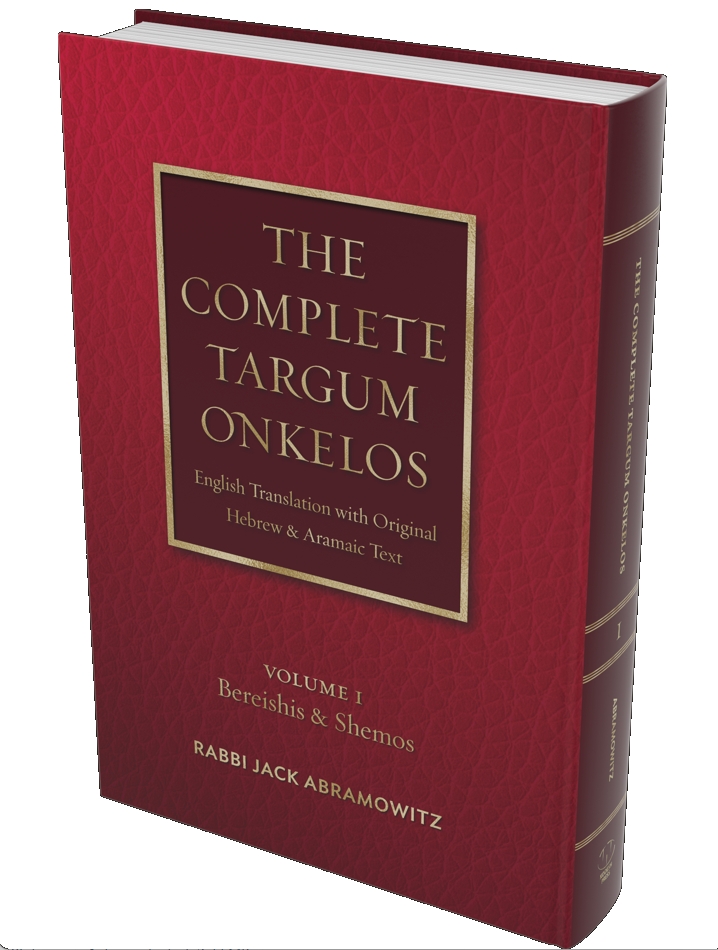Introduction to Shnayim Mikra v’Echad Targum
The Gemara in Brachos (8a-b) tells us that a person should always complete the weekly Torah portion along with the community, twice in the original Hebrew text (“shnayim mikra”) and once in the Aramaic translation of Onkelos (“echad targum”). [Targum Onkelos is actually much more than a translation but we’ll leave that aside for now.] The reason given for the practice is that one who completes the Torah reading with the community will be rewarded by having his days and years extended. While the obligation to review the Torah is codified as halacha in Shulchan Aruch (Orach Chaim 285), the details of how to fulfill this obligation may not always be self-evident. Hopefully, this short series of articles may present a helpful guide to understandinng and performing Shnayim Mikra v’Echad Targum each week.
The Maharal on Shnayim Mikra v’Echad Targum
The Maharal (Nesivos Olam, Nesiv HaAvodah 13:3) explains the reason we review the Torah each week twice in the original text and once in translation. We see that the Torah was given at Sinai, taught again in the Ohel Moed, and then again in the plains of Moav. Regarding the plains of Moav, Deuteronomy 1:5 tells us that Moshe “took it upon himself to expound the Torah,” which Rashi (citing Midrashim) explains means that Moshe then explained the Torah to the people in the seventy languages of the world. Pursuant to this practice, we also review the Torah twice in the original Hebrew and once in translation. The language instituted by Chazal for the review in translation was Aramaic, which was the common language of the Jewish people at the time.
The Levush and the Baal HaTurim on Shnayim Mikra v’Echad Targum
In Hebrew, Shnayim Mikra v’Echad Targum is שנים מקרא ואחד תרגום. The abbreviation for this in Hebrew is שמו”ת – the same as name of the parshas Shemos. Accordingly, the Levush comments on the first words of parshas Shemos:
… ואלה שמות בני ישראל
V’eileh Shemos Bnei Yisroel…
And these are the names of the Children of Israel…
That the letters of the Hebrew phrase stand for
V’chayiv adam likros haparsha shnayim mikra v’echad targum – v’zeh chayavim kol b’nei Yisrael
A person is obligated to review the Torah portion twice in the text and once in translation, and this is an obligation for all Jewry.
The Baal HaTurim extrapolates the entire verse as follows:
V’adam asher lomeid haseder shnayim mikra v’echad targum b’kol naim yashir, yichyeh shanim rabbos aruchim l’olam
A person who learns the weekly Torah portion twice in the text and once in translation in a sweet, steady voice will live many long years.
Shnayim Mikra v’Echad Targum in Shulchan Aruch
The laws of Shnayim Mikra v’Echad Targum as recorded in Shulchan Aruch are actually brief enough that we can encapsulate them here:
1. Even though a person hears the public Torah reading each week, one must also review the sedra twice in the original Hebrew and once in the Targum Onkelos. This includes even proper nouns like the cities of Ataros and Divon in Numbers 32:3;
2. The commentary of Rashi may be reviewed instead of the Targum, though the best practice would be to review both Rashi and the Targum;
3. Reviewing the weekly Torah portion “with the community” means starting on Sunday;
4. The optimum way to fulfill the obligation of Shnayim Mikra v’Echad Targum is to complete the reading before dinner on Friday night. Barring that, one should do so by mincha on Shabbos. Some say that one has until Wednesday of the following week, while others say that one has until Shemini Atzeres. (The Rema explains that Shemini Atzeres – by which we mean Simchas Torah – is when one completes the Torah with the community);
5. Shnayim Mikra v’Echad Targum may be performed during the public Torah reading;
6. Teachers need not repeat the Torah reading themselves as they reviewed it during the week with their students;
7. There’s no Shnayim Mikra v’Echad Targum for yom tov Torah readings.
Of course, these brief laws leave plenty of room for us to ask questions about the details.
How Should One Review Shnayim Mikra v’Echad Targum?
There are a number of different practices when it comes to reviewing the Torah portion. These include reading the weekly sedra a verse at a time, a section at a time and in its entirety. Each of these practices has its halachic proponents. For example, the Maharshal, the Gr”a and others favor reading all the verses in a section twice, followed by the Targum on the verses in that section. The Arizal, Magen Avraham and others favor the practice of reading each verse twice, followed by the Targum on that verse. The Mishnah Brurah (285:2) and the Aruch Hashulchan (OC 285:7) both conclude that either of these practices is acceptable. In fact, the Aruch HaShulchan goes on to note that, since the Rishonim didn’t specify how Shnayim Mikra v’Echad Targum should be reviewed, it’s acceptable for one to review the parsha using a different methodology each week.
Rav Yaakov Kamenetsky ztz”l suggested a novel approach that combined the various practices. He advocated reading a section of the text once, followed by then reviewing the text and the Targum of all the verses in that section individually. Following this, one would proceed to the next section and continue accordingly.
Finally, from the fact that Shnayim Mikra v’Echad Targum may be done during the public reading of the Torah, it would appear self-evident that Shnayim Mikra v’Echad Targum may be performed by reading the sedra in its entirety (see MB 285:14, the aforementioned Aruch HaShulchan, et al.).
The Complete Targum Onkelos
Volume 1: Bereishis and Shemos on Amazon and from Kodesh Press!
Volume 2: Vayikra, Bamidbar and Devarim on Amazon and Kodesh Press!
Two-volume set on Kodesh Press!

